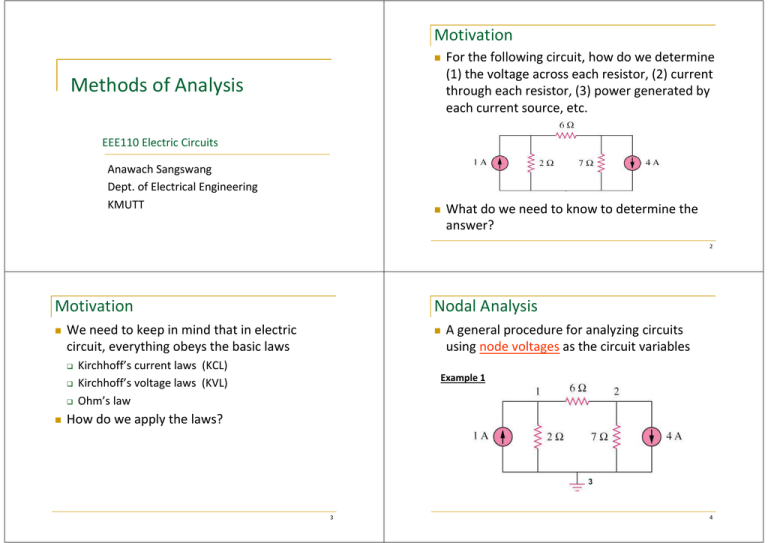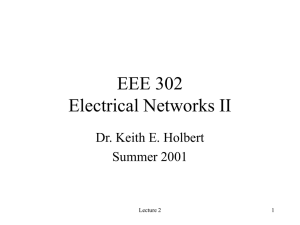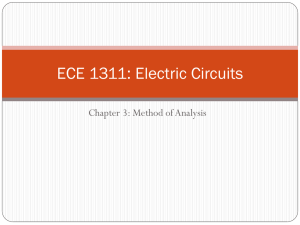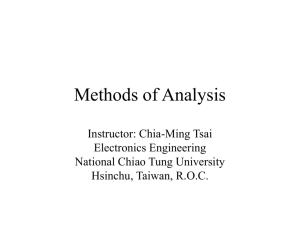Methods of Analysis - web page for staff
advertisement

Motivation For the following circuit, how do we determine (1) the voltage across each resistor, (2) current through each resistor, (3) power generated by each current source, etc. Methods of Analysis EEE110 Electric Circuits Anawach Sangswang Dept. of Electrical Engineering KMUTT What do we need to know to determine the answer? 2 Motivation Nodal Analysis We need to keep in mind that in electric circuit, everything obeys the basic laws A general procedure for analyzing circuits using node voltages as the circuit variables Kirchhoff’s current laws (KCL) Kirchhoff’s voltage laws (KVL) Ohm’s law Example 1 How do we apply the laws? 3 3 4 Nodal Analysis: Steps Nodal Analysis: Steps S1: Select a node as the reference node. S2: Assign voltages v1, v2,…, vn-1 to the remaining n-1 nodes. The voltages are referenced with respect to the reference node. S3: Apply KCL to each of the n-1 non-reference nodes. Use Ohm’s law to express the branch currents in terms of node voltages. S4: Solve the resulting simultaneous equations to obtain the unknown node voltages. Determine v1 and v2 Step 1: Pick the reference node Step 2: Assign voltages to the non-reference nodes v1 and v2 (v1 > v2: arbitrary) Step3: KCL I1 = I 2 + i1 + i2 @Node1: @Node2: I 2 + i2 = i3 5 Nodal Analysis: Steps 6 Example 3.1 Calculate the node voltages Still in step 3: We apply Ohm’s law to express the unknown currents i1, i2, and i3 in terms of node voltages Assigning the voltages and currents Node1: v −0 v −v v −0 i1 = 1 , i2 = 1 2 , i3 = 2 R1 R2 R3 5= The system equations become I1 = I 2 + I2 + v1 v1 − v2 + R1 R2 v1 − v2 v2 = R2 R3 1 1 1 + v1 − v2 = I1 − I 2 R2 R1 R2 1 1 1 − v1 + + v2 = I 2 R2 R2 R3 v1 − v2 v1 + 4 2 Node2: 7 3v1 − v2 = 20 i2 + i4 = i1 + i5 v1 − v2 v + 10 = 5 + 2 4 6 −3v1 + 5v2 = 60 Step4 : Solving for v1 and v2 i1 = i2 + i3 v1 = 20V, v2 = 40 V 3 8 Dependent Current Source Node1: 3 = i1 + ix Node2: ix = i2 + i3 3= v1 − v2 v2 − v3 v2 = + 2 8 4 Node3: i1 + i2 = 2ix Voltage Source v1 − v3 v1 − v2 + 4 2 v1 = 4.8V , v2 = 2.4V , v3 = −2.4V v1 − v3 v2 − v3 v −v + =2 1 2 4 8 2 A super-node is formed by enclosing a dependent or independent voltage source connected between two nonreference nodes and any elements connected in parallel with it. Note: We analyze a circuit with super-nodes using the same steps mentioned before except that the super-nodes are treated differently. 9 Voltage Source KCL@supernode 10 Example 3.3 i1 + i4 = i2 + i3 Find the node voltage v1 − v2 v1 − v3 v2 v3 + = + 2 4 8 6 KCL @supernode KVL@supernode −v2 + 5 + v3 = 0 v2 − v3 = 5 Note 2 = i1 + i2 + 7 The voltage source in the supernode provides a constraint equation needed to solve for the node voltage A supernode requires both KCL and KVL v1 v2 + = −5 2 4 KVL @supernode −v1 − 2 + v2 = 0 11 v2 − v1 = 2 v1 = −7.333V v2 = −5.333V 12 Mesh (Loop) Analysis Mesh Analysis Mesh analysis provides another general procedure for analyzing circuits using mesh currents as the circuit variables Nodal analysis applies KCL to find unknown voltages in a given circuit, while mesh analysis applies KVL to find unknown currents Recall: A loop is a closed path with no node passed more than once Definition: A mesh is a loop which does not contain any other loops within it Is the following a mesh? abefa bcdeb abcdefa Steps S1:Assign mesh currents i1, i2, …, in S2: Apply KVL to each mesh and use Ohm’s law to express the voltages in terms of the mesh currents S3: Solve the resulting n simultaneous equations to get the mesh currents 13 Mesh Analysis 14 Example S1: Assign i1, i2 S2: KVL @ each mesh Find the currents I1, I2, I3 Mesh1 −15 + 5i1 + 10(i1 − i2 ) + 10 = 0 Mesh1 −V1 + i1 R1 + (i1 − i2 ) R3 = 0 or 3i1 − 2i2 = 1 or ( R1 + R3 )i1 − R3i2 = V1 Mesh2 Mesh2 (i2 − i1 ) R3 + i2 R2 + V2 = 0 or −10 + 10(i2 − i1 ) + 6i2 + 4i2 = 0 − R3i1 + ( R2 + R3 )i2 = −V2 or i1 = 2i2 − 1 Solving the above equations gives S3: Just solving for i1 and i2 The branch (measurable) and mesh currents i1 = i2 = 1A Therefore I1 = i1 , I 2 = i2 , I 3 = i1 − i2 I1 = i1 = 1A, I 2 = i2 = 1A, I 3 = i1 − i2 = 0 15 16 Mesh Analysis: Current Source Mesh Analysis: Current Source A current source exists only in one mesh −10 + 4i1 + 6(i1 − i2 ) = 0 i2 = −5 The current source in the supermesh provides the constraint equation necessary to solve the mesh currents A supermesh has no current of its own A supermesh requires the application of both KVL and KCL A current source exists between 2 meshes Supermesh −20 + 6i1 + 10i2 + 4i2 = 0 17 Example Find i1 - i4 Supermesh 6i2 + 2i1 + 4i3 + 8(i3 − i4 ) = 0 KCL@node P: i2 = i1 + 5 KCL@node Q: i3 + 3I o = i2 but Apply KCL to a node in the branch where the meshes intersect i1 + 6 = i2 Solving both equations we get i1 = −3.2 A, i2 = 2.8 A Note I o = −i4 i2 = i3 − 3i4 Mesh4: 8(i4 − i3 ) + 2i4 + 10 = 0 The above equations give i1 = −7.5 A, i2 = −2.5 A, i3 = 3.93 A, i4 = 2.143 A 19 18




